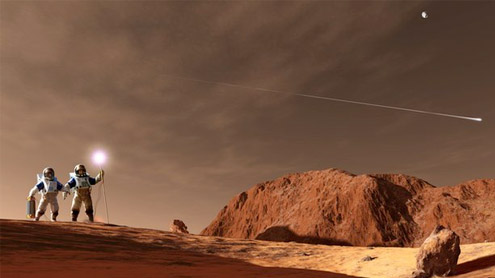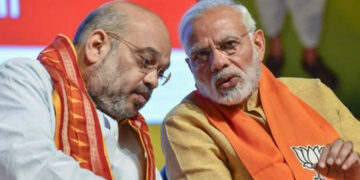
Nasa’s Curiosity rover has confirmed what everyone has long suspected – that astronauts on a Mars mission would get a big dose of damaging radiation.
The robot counted the number of high-energy space particles striking it on its eight-month journey to the planet.Based on this data, scientists say a human travelling to and from Mars could well be exposed to a radiation dose that breached current safety limits.This calculation does not even include time spent on the planet’s surface.When the time devoted to exploring the world is taken into account, the dose rises further still.
This would increase the chances of developing a fatal cancer beyond what is presently deemed acceptable for a career astronaut.Cary Zeitlin from the Southwest Research Institute in Boulder, Colorado, and colleagues report the Curiosity findings in the latest edition of Science magazine.They say engineers will have to give careful consideration to the type of shielding that is built into a Mars-bound crew ship. However, they concede that for some of the most damaging radiation particles, there may be little that can be done to shelter the crew other than to get them to Mars and the partial protection of its thin atmosphere and rocky mass as quickly as possible.
At the moment, given existing chemical propulsion technology, Mars transits take months.”The situation would be greatly improved if we could only get there quite a bit faster,” Dr Zeitlin told BBC News.”It is not just the dose rate that is the problem; it is the number of days that one accumulates that dose that drives the total towards or beyond the career limits. Improved propulsion would really be the ticket if someone could make that work.”New types of propulsion, such as plasma and nuclear thermal rockets, are in development. These could bring the journey time down to a number of weeks.
Curiosity travelled to Mars inside a capsule similar in size to the one now being developed to take astronauts beyond the space station to destinations such as asteroids and even Mars.For most of its 253-day, 560-million-km journey in 2011/2012, the robot had its Radiation Assessment Detector (RAD) instrument switched on inside the cruise vessel, which gave a degree of protection.RAD counts the numbers of energetic particles – mostly protons – hitting its sensors.
The particles of concern fall into two categories – those that are accelerated away from our dynamic Sun; and those that arrive at high velocity from outside of the Solar System.This latter category originates from exploded stars and the environs of black holes.These galactic cosmic rays (GCRs) impart a lot of energy when they strike the human body and will damage DNA in cells. They are also the most difficult to shield against.Earth’s thick atmosphere, its magnetic field and its huge rock bulk provide protection to people living on its surface, but for astronauts in deep space even an aluminium hull 30cm thick is not going to change their exposure to GCRs very much.
The RAD data revealed an average GCR dose equivalent rate of 1.84 milliSieverts (mSv) per day during the rover’s cruise to Mars. (The Sievert is a standard measure of the biological impacts of radiation.) This dose rate is about the same as having a full-body CT scan in a hospital every five days or so.Dr Zeitlin and his team used this measurement as a guide to work out what an astronaut could expect on a Mars mission, assuming he or she had a similarly shielded spacecraft, travelled at a time when the Sun’s activity was broadly the same and completed the journey in just 180 days – Nasa’s “design reference” transit time for a manned mission to Mars.
They calculated the total dose just for the cruise phases to and from Mars to be 660mSv. The team promises to come back with the additional number from surface exposure once Curiosity has taken more measurements at its landing location on the planet’s equator. But even this 660mSv figure represents a large proportion of the 1,000mSv for career exposure that several space agencies work to keep their astronauts from approaching. Reaching 1,000mSv is associated with a 5% increase in the risk of developing a fatal cancer. There would likely be neurological impairment and eyesight damage as well. Nasa actually works to keep its astronauts below a 3% excess risk.
“If you extrapolate the daily measurements that were made by RAD to a 500-day mission you would incur exposures that would cause most individuals to exceed that 3% limit,” explained Dr Eddie Semones, the spaceflight radiation health officer at Nasa’s Johnson Space Center, who added that experts were reviewing the restriction.”Currently, we’re looking at that 3% standard and its applicability for exploration-type missions, and those discussions are going forward on how to handle that and what steps need to be taken to protect the crew.”
All this should be set against the dangers associated with space travel in general, such as launching on a rocket or trying to land on another planet. It is a dangerous business.It also needs to be considered in the context of the risks of contracting cancer during a “normal” lifetime on Earth, which is 26% (for a UK citizen).The space agencies have quite deliberately set conservative limits for their astronauts but it seems clear they would have to relax their rules somewhat or mitigate the risks in some other way to authorise a Mars mission.
However, the scenario for commercial ventures could be very different. Two initiatives – Inspiration Mars and Mars One – have been announced recently that propose getting people to Mars in the next 10 years using existing technologies.Privateer astronauts that participate in these projects may regard the extra risks associated with radiation to be an acceptable gamble given the extraordinary prize of walking on the Red Planet.
Dr Kevin Fong is director of the Centre for Space Medicine at University College London, UK, and has written about the dangers associated with space exploration. He said that what Dr Zeitlin and colleagues had done was help remove some of the uncertainty in the risk assessment.”Radiobiology is actually really tricky because how the body will respond to exposure will depend on many factors, such as whether you’re old or young, male or female,” he told BBC News.”What’s important about this study is that it characterises the deep space radiation environment for the first time in a vehicle whose shielding is not orders of magnitude different from that which you would expect to put a human crew inside.” – BBC











